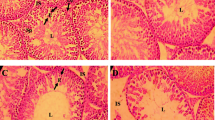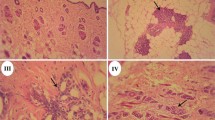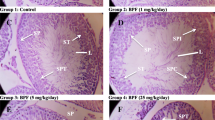Abstract
Bisphenol A (BPA) is involved chemically in the production of some plastics and as a coating for the inner surface of food containers. The current work aimed to investigate the endocrine-disrupting effect of BPA in young and adult female Sprague Dawley rats. Young and adult female rats were exposed orally to 330 mg/kg body weight of BPA dissolved in ethyl alcohol and suspended in corn oil, day after day for 12 weeks. Control rats dosed orally by the solvent only. The samples were collected every 2 weeks for hormonal assays and histopathological examination. The hormonal assays revealed that there was an increase in estradiol concentration in young female; however, in adult ones, estradiol concentration was decreased after 10 and 12 weeks. Progesterone concentration was decreased in adult ones only at 4 weeks, while testosterone hormone was increased in young female rats. The histopathological finding revealed that there were polycystic follicles in the ovaries of young female, while in adult ones, there were atretic follicles. In conclusion, BPA exposure resulted in endocrine disruption indicated by different responses in hormonal and histopathological changes in both young and adult female rats.




Similar content being viewed by others
References
Adewale HB, Jefferson WN, Newbold RR, Patisaul HB (2009) Neonatal bisphenol-a exposure alters rat reproductive development and ovarian morphology without impairing activation of gonadotropin-releasing hormone neurons. Biol Reprod 81:690–699
Beronius A, Rudén C, Håkansson H, Hanberg A (2010) Risk to all or none? A comparative analysis of controversies in the health risk assessment of bisphenol A. Reprod Toxicol 29:132–146
Boone DL, Tsang BK (1998) Caspase-3 in the rat ovary: localization and possible role in follicular atresia and luteal regression. Biol Reprod 58:1533–1539
Cabaton NJ, Wadia PR, Rubin BS, Zalko D, Schaeberie CM, Askenase MH (2011) Perinatal exposure to environmental relevant levels of bisphenol A decreases fertility and fecundity in CD-1 mice. Environ Health Perspect 119:547–552
Calafat AM, Kuklenyik Z, Reidy JA, Caudill SP, Ekong J, Needham LL (2004) Urinary concentrations of bisphenol A and 4-nonylphenol in a human reference population. Environ Health Perspect 113:391–395
Chen D, Kannan K, Tan H, Zheng Z, Feng YL, Wu Y, Widelka M (2016) Bisphenol analogues other than BPA: environmental occurrence, human exposure, and toxicity—a review. Environ Sci Technol 50(11):5438–5453
Chen W, Lau SW, Fan Y, Wu RSS, Ge W (2017) Juvenile exposure to bisphenol A promotes ovarian differentiation but suppresses its growth—potential involvement of pituitary follicle-stimulating hormone. Aquat Toxicol 193:111–121
Delclos KB, Camacho L, Lewis SM, Vanlandingham MM, (2013) Latendresse JR, Olson GR. Toxicity evaluation of bisphenol A administered by gavage to Sprague Dawley rats from gestation day 6 through postnatal day 90. Toxicol Sci 139: 174–197.
Dominguez MA, Petre MA, Neal MS, Foster WG (2008) Bisphenol A concentration-dependently increases human granulosa-lutein cell matrix metalloproteinase-9 (MMP-9) enzyme output. Reprod Toxicol 25:420–425
Fernandez M, Bourguignon N, Lux-Lantos V, Libertun C (2010) Neonatal exposure to bisphenol A and reproductive and endocrine alterations resembling the polycystic ovarian syndrome in adult rats. Environ Health Perspect 118:1217–1222
Flint S, Markle T, Thompson S, Wallace E (2012) Bisphenol A exposure, effects, and policy: a wildlife perspective. J Environ Manag 104:19–34
Fukazawa H, Hoshino K, Shiozawa T, Matsushita H, Terao Y (2001) Identification and quantification of chlorinated bisphenol A in waste water from waste paper recycling plant. Chemosphere 44:973–979
Grasselli F, Baratta L, Baioni L, Bussolati S, Ramoni R, Grolli S (2010) Bisphenol A disrupts granulosa cell function. Domest Anim Endocrinol 39:34–39
Hanioka N, Jinno H, Nishimura T, Ando M (2001) Suppression of male-specific cytochrome P450 isoforms by bisphenol A in rat liver. Arch Toxicol 1998(72):387–394
Irving-Rodgers HI, van Wezel M, Mussard JK, Rodgers R (2001) Atresia revisited: two basic patterns of atresia of bovine antral follicles. Reproduction 122:761–775
Kandaraki E, Chatzigeorgiou A, Livadas S, Palioura E, Economou F, Koutsilieris M, Palimeri S, Panidis D, Diamanti-Kandarakis E (2011) Endocrine disruptors and polycystic ovary syndrome (PCOS): elevated serum levels of bisphenol A in women with PCOS. J Clin EndocrinolMetab 96:480–484
Kenziorski J, Belcher S (2015) Strain specific induction of endometrial periglandular fibrosis in mice exposed during adulthood to endocrine disrupting chemical bisphenol A. Repro Toxicol 58:119–130
Kloas W, Lutz I, Einspanier R (1999) Amphibians as a model to study endocrine disruptors: II. Estrogenic activity of environmental chemicals in vitro and in vivo. Sci Total Environ 225:59–68
Lawson C, Gieske M, Murdoch B, Ye P, Li Y, Hassold T, Hunt PA (2011) Gene expression in the fetal mouse ovary is altered by exposure to low doses of bisphenol A. Biol Reprod 84:79–86
Levesque R. (2007) SPSS programming and data management: guide for SPSS and SAS users, fourth edition, SPSS Inc., Chicago III. PDF ISBN 1-56827-390-8.
Markey CM, Coombs MA, Sonnenschein C, Soto AM (2003) Mammalian development in a changing environment: exposure to endocrine disruptors reveals the developmental plasticity of steroid-hormone target organs. Evol Dev 5:67–75
Mohamad ZS, Kassim NM, Othman S. (2015) Tualang honey protects against BPA-induced morphological abnormalities and disruption of ERα, ERβ, and C3 mRNA and protein expressions in the uterus of rats. Evidence-based complementary and alternative medicine eCAM, 202874
Morrissey RE, George JD, Price CJ, Tyl RW, Marr MC, Kimmel CA (1987) The developmental toxicity of bisphenol A in rats and mice. J Fundam Appl Toxicol 8:571–582
Nah WH, Park MJ, Gye MC (2011) Effects of early prepubertal exposure to bisphenol A on the onset of puberty, ovarian weights, and estrous cycle in female mice. Clin Exp Reprod Med 38:75–81
Newbold RR, Padilla-Banks E, Snyder RJ, Phillips TM, Jefferson WN (2007) Developmental exposure to endocrine disruptors and obesity epidemic. Reprod Toxicol 23:290–296
Norman RJ, Dewailly D, Legro RS, Hickey TE (2007) Polycystic ovary syndrome. Lancet 370:685–697
Othman ER, Dina MM, Dalia AE, Nagwa G, Sawsan E (2016) Bisphenol A concentrates preferentially in human uterine leiomyoma and induces proliferation in rat myometrium. Reprod Sci 23:508–514
Papaconstatinou AD, Umbreit TH, Fisher BR, Georing PL, Lappas NT, Brown KM (2000) Bisphenol A-induced increase in uterine weight and alterations in uterine morphology in ovariectomized B6C3F1 mice: role of the estrogen receptor. Toxicol Sci 56:332–339
Patisaul HB, Todd KL, Mickens JA, Adewale HB (2009) Impact of neonatal exposure to the ERalpha agonist PPT, bisphenol-A or phytoestrogens on hypothalamic kisspeptin fiber density in male and female rats. Neurotoxicology 30:350–357
Peretz J, Gupta RK, Singh J, Hernández-Ochoa I, Flaws JA (2011) Bisphenol A impairs follicle growth, inhibits steroidogenesis, and down regulates rate-limiting enzymes in the estradiol biosynthesis pathway. Toxicol Sci 119:209–217
Raloff J (2009) Body & brain: BPA in womb lined to childhood behavior: found for exposure during first 16 weeks of pregnancy. Science News 176:12
Ranjit N, Siefert K, Padmanabhan V (2010) Bisphenol A and disparities in birth outcomes: a review and directions for future research. J Perinatol 30:2–9
Rivera OE, Varayoud J, Rodriguez HA, Munoz-de-Toro M, Luque EH (2011) Neonatal exposure to bisphenol A or diethylstilbestrol alters the ovarian follicular dynamics in the lamb. Reprod Toxicol 32:304–312
Rochester JR (2013) Bisphenol A and human health: a review of the literature. Reprod Toxicol 42:132–155
Rodríguez HA, Santambrosio N, Santamaría CG, Muñoz-de-Toro M, Luque EH (2010) Neonatal exposure to bisphenol A reduces the pool of primordial follicles in the rat ovary. Reprod Toxicol 30:550–557
Romani F, Tropea A, Scarinci E, Dello Russo C, Lisi L, Catino S, Lanzone A, Apa R (2013) Endocrine disruptors and human corpus luteum: in vitro effects of phenols on luteal cells function. J Environ Sci Health C Environ Carcinog Ecotoxicol Rev 31:170–180
Rubin BS (2011) Bisphenol A: an endocrine disruptor with widespread exposure and multiple effects. J Steroid Biochem Mol Biol 127:27–34
Schönfelder G, Wittfoht W, Hopp H, Talsness CE, Paul M, Chahoud I (2002) Parent bisphenol A accumulation in the human maternal-fetal-placental unit. Environ Health Perspect 110:A703–A707
Seung GL, Ji YK, Jin YC, Yoon JK, Ji EP, Seunghoon OH, Yong DY, Ki SY, Young HY, Jong MK (2013) Bisphenol A exposure during adulthood causes augmentation of follicular atresia and luteal regression by decreasing 17β-estradiol synthesis via downregulation of aromatase in rat ovary. Environ Health Perspect 121:663–669
Signorile PG, Spugnini EP, Mita L, Mellone P, D’Avino A, Bianco M, Diano N, Caputo L, Rea F, Viceconte R, Portaccio M, Viggiano E, Citro G, Pierantoni R, Sica V, Vincenzi B, Mita DG, Baldi F, Baldi A (2010) Pre-natal exposure of mice to bisphenol A elicits an endometriosis-like phenotype in female offspring. Gen Comp Endocrinol 168:318–325
Siti S, Mohamad Z, Normadiah, MK, Shatrah O. (2015) Tualang honey protects against BPA-induced morphological abnormalities and disruption of ERα, ERβ, and C3 mRNA and protein expressions in the uterus of rats. Evid. Based complement Alternat. Med. 202874.
Soto AM, Maffini MV, Schaeberle CM, Sonnenschein C (2006) Strengths and weaknesses of in vitro assays for estrogenic and androgenic activity. Best Practice Res Clinical Endocrinology Metabolism 20:15–33
Stocco DM (2001) StAR protein and the regulation of steroid hormone biosynthesis. Annu Rev Physiol 63:193–213
Stocco C (2008) Aromatase expression in the ovary: hormonal and molecular regulation. Steroids 73:473–487
Talsness CE, Andrade AG, Kuriyama SN, Talylor JA, VomSaal FS (2009) Components of plastic: experimental studies in animals and relvance for human health. Philos Trans R Soc Lond Biol Sci 27:2079–2096
Tunmise TM, Patrick OU (2015) Effect of tamoxifen and flutamide-induced receptor blockade on bisphenol a (BPA) activity in male albino wistar rats. Basic Sci Medicine 4:21–27
Vandenberg LN, Colborn T, Hayes TB, Heindel JJ, Jacobs DR Jr, Lee DH, Shioda T, Soto AM, vom Saal FS, Welshons WV, Zoeller RT, Myers JP (2012) Hormones and endocrine-disrupting chemicals: low-dose effects and nonmonotonic dose responses. Endocr Rev 33:378–455
Vandenberg LN, Hauser R, Marcus M, Olea N, Welshons WV (2007) Human exposure to bisphenol A (BPA). Reproductive Toxicology 24:139–177
Vandenberg LN, Maffini MV, Sonnenschein C, Rubin BS, Soto AM (2009) Bisphenol A and the great divide: a review of controversies in the field of endocrine disruption. Endocrine Rev 30:75–95
Wang F, Pan J, Liu Y, Meng Q, Lv P, Qu F, Huang H (2015) Alternative splicing of the androgen receptor in polycystic ovary syndrome. Proc Natl Acad Sci U S A 112:4743–4748
Yin L, Burns KA, Arao Y, Luh CJ, Kenneth SK (2012) Differential estrogenic actions of endocrine-disrupting chemicals bisphenol A, bisphenol AF, and zearalenone through estrogen receptor α and β in vitro. Environ Health Perspect 120:1029–1035
Zhou W, Liu J, Liao L, Han S, Liu J (2008) Effect of bisphenol A on steroid hormone production in rat ovarian theca-interstitial and granulosa cells. Mol Cell Endocrin 283:12–18
Author information
Authors and Affiliations
Corresponding author
Ethics declarations
All procedures involving animals were done in accordance with the ethical standards of Assiut University. All rats were handled according to the standard guidelines for care and use of experimental animals.
This article does not contain any studies with human participants performed by any of the authors
Conflict of interest
The authors declare that they have no conflict of interest.
Rights and permissions
About this article
Cite this article
Hamdy, H., Yahia, D., Afifi, S. et al. Endocrine disruption induced by bisphenol A in young and adult female Sprague Dawley rats. Comp Clin Pathol 27, 967–974 (2018). https://doi.org/10.1007/s00580-018-2689-2
Received:
Accepted:
Published:
Issue Date:
DOI: https://doi.org/10.1007/s00580-018-2689-2




